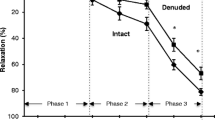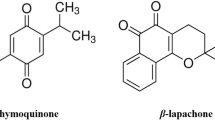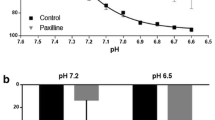Abstract
The interaction of superoxide anions (O2 –) generated by menadione with the synthesis and/or action of nitric oxide (NO), prostacyclin (PGI2) and endothelium-derived hyperpolarizing factor (EDHF) was investigated in segments of the left anterior descending coronary artery (LAD) isolated from bovine hearts. EDHF and NO release were monitored by superfusion bioassay in segments pre-constricted with the thromboxane mimetic, U46619, PGI2 release in addition by enzyme immunoassay for 6-keto-prostaglandin F1α, and generation of O2 – by lucigenin-enhanced chemiluminescence. Bradykinin (1–1,000 pmol) elicited a prominent, endothelium-dependent, relaxant response, 50–60% of which was insensitive to combined blockade of cyclooxygenase with diclofenac (1 µM) and NO synthase with N G-nitro-l-arginine (50 µM). This diclofenac/N G-nitro-l-arginine-insensitive relaxant response was completely abrogated in the presence of tetrabutylammonium (3 mM), a non-selective inhibitor of Ca2+-dependent K+ channels, or when the segments were pre-constricted with potassium chloride (60 mM) instead of U46619, and thus most likely mediated by EDHF. Despite causing a two- to fourfold increase in the concentration of O2 – in or at the vessel wall, menadione (30 µM) did not affect the diclofenac/N G-nitro-l-arginine-insensitive relaxant response to bradykinin. When administered in the absence of N G-nitro-l-arginine, however, menadione significantly inhibited the relaxant response to bradykinin, presumably by attenuating the NO-mediated relaxation. Menadione also abolished the bradykinin-stimulated release of PGI2 from luminally perfused segments of the LAD. This effect was more pronounced in the absence of N G-nitro-l-arginine, indicating that PGI2 release in this preparation may be more sensitive to inhibition by peroxynitrite, the reaction product of NO and O2 –, than to O2 – alone. These findings suggest that, in contrast to NO and PGI2, the release, and presumably also the mechanism of action, of EDHF in the bovine LAD is resistant to an increase in the local concentration of O2 – or peroxynitrite which is thought to play an important role in coronary heart disease.
Similar content being viewed by others
Author information
Authors and Affiliations
Additional information
Received: 27 August 1998 / Accepted: 18 November 1998
Rights and permissions
About this article
Cite this article
Kaw, S., Hecker, M. Endothelium-derived hyperpolarizing factor, but not nitric oxide or prostacyclin release, is resistant to menadione-induced oxidative stress in the bovine coronary artery. Naunyn-Schmiedeberg's Arch Pharmacol 359, 133–139 (1999). https://doi.org/10.1007/PL00005332
Issue Date:
DOI: https://doi.org/10.1007/PL00005332




